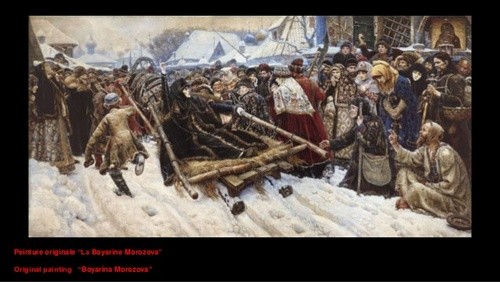
An inconvenient formalism
Although the Russian Church has evolved at the same pace as the Muscovite state, its religious formalism is beginning to disturb. In the West, the Reformation already took place in the 16th century. In Russia, the Church takes up a lot of space to the point of being proud of its prestige. Although it was born at the same time as the Muscovite state, the Church is struggling to keep up.
Moscow got its first patriarch in 1589 named Job. In 1652, Nikon took on this role, and he decided to shake up the traditional rites of the Orthodox Church in the same way as the Reformation of Luther and Calvin. He begins by returning to the errors in Slavonic in the sacred texts, as well as the verification of religious gestures. Between 1654 and 1656, councils approve these modifications - or rectifications - in the religious functioning. However, they are far from pleasing everyone.
Avvakoum versus Nikon
Despite accepting the relatively minor reforms proposed by Patriarch Nikon, Archpriest Avvakum manifests his firm opposition to any change. Other priests and lay people are of the same opinion, and therefore refuse ecclesiastical authority:this disagreement marks the beginning of Raskol . In 1658, Nikon broke with the Tsar, asserting the superiority of the Church over the State.
The brutality of the changes made by Nikon led to hostility among the conservatives. Avvakoum even accuses Nikon of being heretical. This is when the choice must be made:either the reluctant religious leaders submit to the reforms approved by the councils, or they defy the church. Two clans are then formed.
The Old Believers
The reluctant who prefer to challenge the church - for example by refusing the new religious gestures or the new spelling of Jesus - are called the "old believers". Whether they were merchants, peasants or Cossacks, like Karazine, the Old Believers formed a parallel church in which Nikon embodied the figure of the antichrist. Among them, some still wish to benefit from the sacraments of the official Church, and thus collaborate with the latter.
However, the Old Believers were soon persecuted. Unlike the Protestant Reformation, it was the conservatives who suffered the gall of the reformers. Nearly twenty thousand people were burned, including Avvakoum in 1682; these killings are accompanied by collective suicides. Resistance however took place, in particular that of the monastery of Solovetski which lasted several years. Boyarin Morozova is one of the best-known supporters of the Old Believers movement.
A schism that weakens the Orthodox Church
It is without regret that the Church excommunicates its most faithful believers. And yet, it was certainly among the Old Believers that the most quick-witted and business-minded were to be found. But these men lived underground, independent of the state. They could not fly to the aid of the Church, which was considerably weakened.
A question regarding Raskol still remains and divides historians:was this Nikon's Reform aimed at modernizing the Church to attract people? What is certain is that this schism facilitated the anti-religious task of Peter the Great who would attack him once on the throne.
